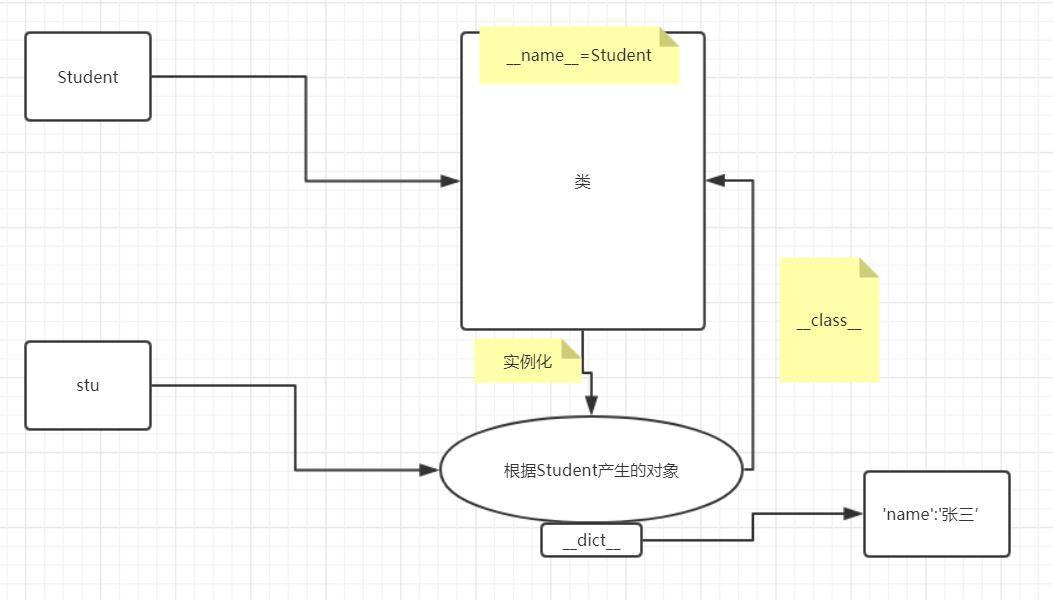类
- 分类/类别
- 上述的代码(张三,李四,王五,小明):按照学生和老师可以分为两类,而按照学校则可以划分为一类
- 所以类是抽象的,并不是固定的,是一种思想
- 类的概念:一系列具有共同特征(属性)或技能(方法)的对象
- 类的作用:
- 在现实生活中,是先有对象,再根据对象划分出类,但在Python中,是先定义类,再实例化对象(根据抽象的类,生成具体的对象)
- 类的定义:
- class 类名(使用大驼峰):
- 特征(属性)
- 技能(方法)
- class 类名(使用大驼峰):
定义类和对象
# 造函数
def f1():
# 1/0 # 不报错,函数定义阶段只检验语法,不执行代码
school = 'a中'
# 造类(经典类,新式类)
class Student: #不要写小括号,小括号是继承
# 1/0 # 报错,类的定义阶段会运行代码
school = 'a中'
def eat(self):
print('吃饭')
print(Student.__name__) # 打印类名
student_dict = Student.__dict__ # 双下划线开头的方法会在某种情况下自动触发
print(student_dict)
print(student_dict['school'])
student_dict['eat'](111)
Student
{'__module__': '__main__', 'school': 'a中', 'eat': <function Student.eat at 0x0000022334A4E8C8>, '__dict__': <attribute '__dict__' of 'Student' objects>, '__weakref__': <attribute '__weakref__' of 'Student' objects>, '__doc__': None}
a中
吃饭
实例化:
# 造对象(实例化对象)
stu1 = Student()
print(1, stu.school)
print(stu1.__class__) # 也可以通过这个方法来修改这个对象所绑定的类
stu2 = Student()
print(2, stu2.school)
print(stu2.__class__)
1 a中
<class '__main__.Student'>
2 a中
<class '__main__.Student'>
__dict__ 和__class__
- 类和对象中的属性,都是存放在__dict__中
- 对象的__dict__可以直接进行修改,如
stu1.__dict__ = {'num': 1,'name': '张三'}但是类的__dict__属性是只读的,不能进行修改 - __class__可以用来查看对象所绑定的类,也可以通过它来进行修改绑定在哪个类上
创建对象时的底层运作

定义对象独有的特征
print(Student.__dict__)
print('stu1', stu1.__dict__)
# 以下两种定义方式等价
# stu1.__dict__['num'] = 1 # 使用字典的方法
stu1.num = 1 # 使用对象的方法
print(stu1.__dict__)
print(Student.__dict__)
{'__module__': '__main__', 'school': 'a中', 'eat': <function Student.eat at 0x00000236C327E8C8>.......}
stu1 {}
{'num': 1}
{'__module__': '__main__', 'school': 'a中', 'eat': <function Student.eat at 0x00000236C327E8C8>.......}
对象的方法是独有的,且对类没有影响
class Student:
school = 'a中'
count = 0
stu1 = Student()
stu1.count += 1
stu2 = Student()
stu2.count +=1
stu3 = Student()
stu3.count += 1
print(Student.count)
0 # 加的都是对象中的,并没有影响到类
给对象添加属性
# 把特征(特征)都加上去
stu1.name = '张三'
stu1.age = 19
print(stu1.num, stu1.name, stu1.age)
# 李四的特征
stu2.num = 2
stu2.name = '李四'
stu2.age = 20
print(stu2.num, stu2.name, stu2.age)
# 这样加太繁琐了,如果对象多会很麻烦
1 张三 19
2 李四 20
init
# 用一个函数把这个重复定义的过程封装起来
def init(obj, num, name, age):
obj.num = num
obj.name = name
obj.age = age
# 和上面的代码效果等价
init(stu1, 1, '张三', 19)
init(stu2, 2, '李四', 20)
print(stu1.__dict__)
print(stu2.__dict__)
{'num': 1, 'name': '张三', 'age': 19}
{'num': 2, 'name': '李四', 'age': 20}
- 那么我们把这个init函数写到类里去
- 每次实例化对象的时候都会自动调用__init__方法,且优先级最高
class Student:
school = 'a中'
count = 0
# self就是实例化的对象,是约定俗成的写法,和上面的obj是一样的, __init__在实例化的时候会自动传值
def __init__(self, num, name, age): # self = stu1 self = stu2
self.num = num
self.name = name
self.age = age
Student.count += 1
def ear(self):
print('吃饭')
stu1 = Student(1, '张三', 19) # 每次实例化对象的时候都会自动调用
print(stu1.num, stu1.name, stu1.age)
stu2 = Student(2, '李四', 20)
print(stu2.num, stu2.name, stu2.age)
print(Student.count)
1 张三 19
2 李四 20
2 # 每次实例化的时候都自动运行了init中的代码
_slots_(了解)
- 限制该类实例化的对象中可添加的属性
class Student:
__slots__ = ['num'] # 只能添加num
pass
stu1 = Student()
stu1.num = 1 # 添加成功
stu1.name = '张三' # 报错
给对象添加属性时的底层运作
